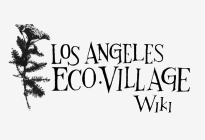The first buildings on the street the Eco-Village is situated on contained a large complex of bathing pools naturally fed by underground mineral springs, known as the Bimini Baths. They were begun in the first decade of the 1900’s. Most residents of the Los Angeles area were familiar with them or swam in them until 1950 when they closed. They were so popular and successful that a resident hotel for guests (now the Mary Lind Foundation) of the Baths and apartment buildings for Bath workers (now the CRSP-owned buildings of the LA Eco-Village) were built. A special spur of the Los Angeles rail line ran down to the Baths. And, in 1925, one of the most successful nightclubs in Los Angeles, the Palomar Ballroom, was opened on the footprint that is now Vons on Third Street.
At the beginning of the 20th century, hot-springs were found in what is know today as Bimini Pl. Drillers looking for oil found the waters at 1,750 feet below the surface. The first pool was filled in 1903 and the bimini baths were open to the public for almost 50 years. The neighborhood grew around Bimini baths. There was a movie house, a bowling alley, and the once upon a time famous Palomar Ballroom. The baths were torn down in 1956.
The baths were owned by David W. Edwards who named them after the Bimini Islands in the Bahamas where, rumor has it, Spanish explorer Juan Ponce de Leon was looking for the fountain of youth.
The site is now occupied by the Mijoo Peace Church, and auto repair shop and the Bresee Community Center. There is no known access to the hot-springs.
There is an Article that was published in the LA Times in 2004 with extensive information about the history of the Bimini Baths.
External Links:

